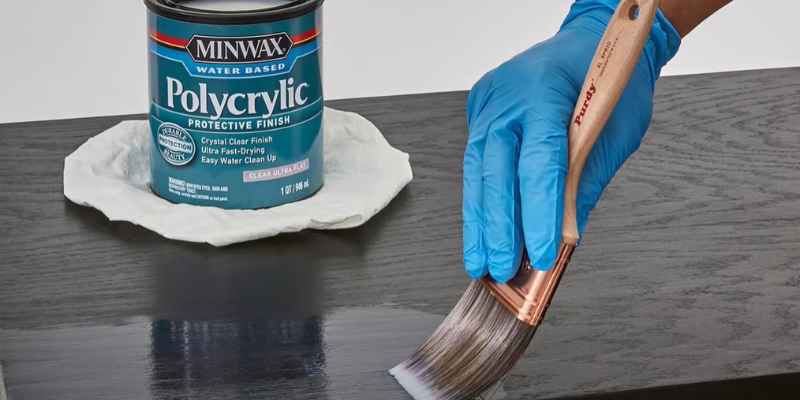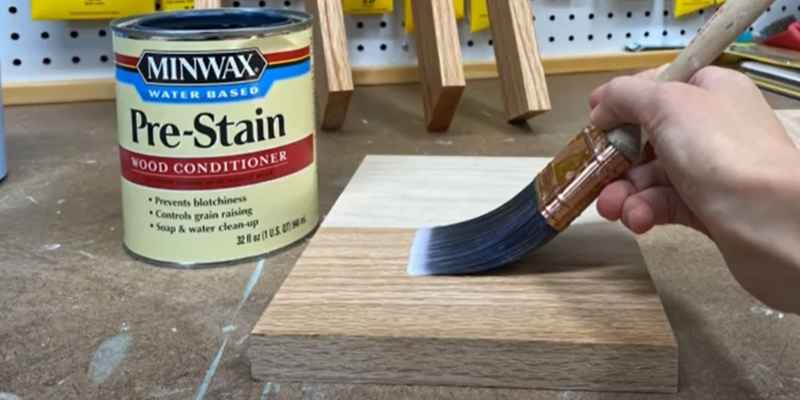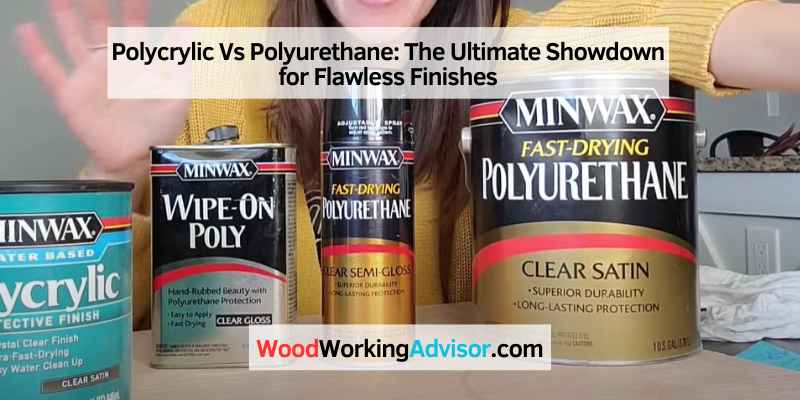Polycrylic and polyurethane are two popular types of protective finishes used on wood surfaces. Polycrylic dries faster and is water-based, while polyurethane is oil-based and offers better durability against heat and chemicals.
Now let’s take a closer look at each option to understand their specific characteristics and applications. Polycrylic and polyurethane are often used as protective finishes for wood surfaces. Polycrylic is a water-based finish that dries quickly, making it a good choice for projects that require faster completion.
On the other hand, polyurethane is oil-based and provides better heat and chemical resistance. However, it takes longer to dry compared to polycrylic. Both finishes offer durability and protection to wood surfaces, but the choice between polycrylic and polyurethane depends on the specific project requirements and personal preferences. In the following sections, we will explore the features, applications, and pros and cons of each finish to help you make an informed decision.
1. What Are Polycrylic And Polyurethane?
Polycrylic and polyurethane are two popular finishes used in woodworking projects to protect and enhance the appearance of different surfaces. Each option offers its own unique benefits and considerations, which we’ll explore in detail below.
1.1 Polycrylic
Polycrylic is a water-based protective finish that is widely used for its durability and versatility. This type of finish is known for its clear, transparent appearance, which allows the natural beauty of the wood to shine through. It creates a protective barrier that shields the wood from scratches, stains, and moisture damage.
One of the major advantages of using polycrylic is its quick drying time. Unlike other finishes that can take several hours or even days to dry, polycrylic typically dries within a few hours. This makes it a great option for projects that require multiple coats or those with time constraints. Additionally, polycrylic has a low odor, making it more user-friendly, especially for those with sensitivities to strong smells.
Another benefit of polycrylic is its easy application. It can be applied using various methods, including brushing, spraying, or wiping with a cloth. This versatility allows for greater customization and ease of use, depending on the project requirements and personal preferences.
1.2 Polyurethane
Polyurethane is another commonly used finish in woodworking that provides excellent protection and enhances the longevity of the wood. Unlike polycrylic, polyurethane is available in both water-based and oil-based formulations, each with its own properties and characteristics.
Water-based polyurethane is known for its quick drying time, similar to polycrylic, making it a convenient option for time-sensitive projects. It also offers excellent resistance to yellowing over time, maintaining the natural color of the wood for longer periods.
On the other hand, oil-based polyurethane provides added durability and depth to the wood surface. It tends to enhance the appearance of the wood, giving it a warm and rich finish. However, oil-based polyurethane has a longer drying time compared to its water-based counterpart.
When it comes to application, both water-based and oil-based polyurethane can be applied using various methods such as brushing or spraying. However, it is worth noting that oil-based polyurethane is typically harder to clean up as it requires solvents for removal.
In conclusion, polycrylic and polyurethane are two viable options for finishing woodworking projects. The choice between the two depends on factors such as drying time, odor, ease of application, and desired finish appearance. By understanding the characteristics of each finish, you can select the one that best suits your specific project requirements and enhances the beauty of your woodwork.

2. Differences Between Polycrylic And Polyurethane
When it comes to protective finishes for your furniture or other wood projects, two popular options are polycrylic and polyurethane. While they may seem similar, there are several key differences between the two. Understanding these differences can help you choose the right finish for your specific needs. In this section, we will explore the differences between Polycrylic and Polyurethane, including their chemical makeup, application process, drying time, durability, and appearance.
2.1 Chemical Makeup
The chemical makeup of polycrylic and polyurethane can impact their performance and properties. Polycrylic is a water-based finish, meaning it contains acrylic polymers suspended in water. On the other hand, polyurethane is an oil-based finish, typically made with synthetic resins dissolved in petroleum-based solvents. This fundamental difference in composition affects how the finishes behave, how they adhere to surfaces, and the level of odor they emit.
2.2 Application Process
The application process for polycrylic and polyurethane differs slightly. Polycrylic is easy to apply with a brush or roller, and it can also be sprayed. It has a milky appearance when applied but dries clear. Polyurethane, especially the oil-based variant, requires more careful handling and precision during application. It can often result in visible brush strokes or bubbles if not applied correctly. Additionally, polyurethane typically requires more coats for optimal protection.
2.3 Drying Time
When it comes to drying time, polycrylic has an advantage over polyurethane. Polycrylic dries relatively quickly, often within two hours or less between coats, making it a popular choice for those who want to complete their projects quickly. Polyurethane, especially the oil-based type, takes longer to dry and cure. It can take up to 24 hours or even longer before you can apply a second coat or handle the finished piece without leaving imprints.
2.4 Durability
When it comes to durability, both polycrylic and polyurethane offer good protection for wood surfaces. However, polyurethane, particularly the oil-based version, is generally considered more durable and resistant to scratches, heat, and water damage. It forms a hard and thick protective layer that can withstand heavy use and exposure to various elements. Polycrylic, while still providing decent protection, may not be as long-lasting or as resistant to wear and tear.
2.5 Appearance
The appearance of the finish is another important factor to consider. Polycrylic dries clear, leaving the natural beauty of the wood intact. It has a slightly glossy finish that enhances the wood’s colors and grain. Polyurethane, on the other hand, can have various finishes, including glossy, satin, or matte. It can darken the wood slightly, giving it a deeper, richer appearance. The choice between polycrylic and polyurethane may depend on the desired look you want to achieve for your project.
3. Pros And Cons Of Polycrylic
Polycrylic and polyurethane have their own set of pros and cons. Polycrylic is easier to apply and dries faster, but it may not provide as durable a finish as polyurethane. On the other hand, polyurethane offers excellent durability but requires more time for application and drying.
Choose the one that best suits your needs and preferences.
If you are looking for a durable and protective finish for your woodworking projects, you may have come across both Polycrylic and Polyurethane. While both options offer their own set of advantages and disadvantages, in this section, we will focus on examining the pros and cons of Polycrylic. By understanding these key factors, you can make an informed decision about which finish is best suited for your specific needs.
3.1 Advantages Of Polycrylic
Polycrylic is a popular choice among woodworkers due to its numerous advantages:
- Easy Application: One of the biggest benefits of Polycrylic is its simple and easy application process. Unlike other finishes that require extensive preparation and expertise, Polycrylic can be applied with a brush, roller, or spray gun, making it a convenient option for both professionals and DIY enthusiasts.
- Quick Drying Time: Time is often a critical factor when it comes to completing woodworking projects. With Polycrylic, you won’t have to wait for long hours for the finish to dry. This water-based finish dries quickly, allowing you to move on to the next step of your project without unnecessary delays.
- Enhances Natural Wood Characteristics: Polycrylic provides a clear and transparent finish that allows the natural beauty of the wood to shine through. It does not alter the color or appearance of the wood, making it an ideal choice for preserving and enhancing the natural grain patterns and textures.
- Offers UV Protection: Sunlight can cause wooden surfaces to fade and lose their luster over time. However, Polycrylic offers excellent UV resistance, helping to protect your wood from the damaging effects of the sun’s rays. This makes it an ideal choice for exterior woodworking projects that are exposed to sunlight.
3.2 Disadvantages Of Polycrylic
While Polycrylic offers numerous advantages, it also comes with a few drawbacks that you should consider:
- Not as Durable as Polyurethane: When it comes to durability, Polycrylic is not as robust as Polyurethane. While it provides a decent level of protection, it may not stand up as well to heavy wear and tear or high-traffic areas.
- Susceptible to Heat and Water Damage: Although Polycrylic is water-based and offers some resistance to water, it is not completely impervious. Prolonged exposure to water or high levels of humidity can result in damage or degradation of the finish. In addition, Polycrylic may also become clouded or develop a white haze when exposed to extreme heat or moisture.
- Requires Multiple Coats: To achieve the desired level of protection and durability with Polycrylic, multiple coats are usually required. Each coat needs to dry thoroughly before applying the next layer, which can add extra time to the finishing process.
By understanding the advantages and disadvantages of Polycrylic, you can make an informed decision about whether it is the right finish for your woodworking projects. Consider factors such as the desired level of durability, the specific environment the wood will be exposed to, and the overall aesthetic you wish to achieve.
4. Pros And Cons Of Polyurethane
When it comes to choosing the right protective finish for your woodworking projects, polyurethane is often a top contender. This versatile and durable coating provides a glossy or satin sheen to your surfaces, while also protecting them from wear and tear. However, like any product, polyurethane has its own set of advantages and disadvantages. In this section, we’ll dive into the pros and cons of using polyurethane as a finish for your projects.
4.1 Advantages Of Polyurethane
Polyurethane offers several advantages that make it a popular choice among woodworkers:
- 1. Durability: Polyurethane creates a tough protective layer that can withstand daily use and helps prolong the lifespan of your woodwork.
- 2. Versatility: This finish can be used on a variety of surfaces, including wood, metal, and plastic, making it suitable for different types of projects and materials.
- 3. Water resistance: Polyurethane is known for its excellent water resistance, making it ideal for surfaces that may come into contact with liquids or high humidity environments.
- 4. Easy application: With its liquid form, polyurethane can be applied easily using a brush, roller, or spray, allowing for a smooth and even finish.
- 5. UV protection: Some polyurethane products offer UV inhibitors that protect the underlying surfaces from the damaging effects of the sun’s rays, preventing discoloration and fading.
4.2 Disadvantages Of Polyurethane
While polyurethane offers many benefits, it also comes with a few drawbacks:
- 1. Drying time: Polyurethane typically has a longer drying time compared to other finishes, which means you’ll need to wait longer before applying additional coats or handling the project.
- 2. Odor: Some polyurethane products can emit a strong odor during application and curing, so it’s important to work in a well-ventilated area or use a respirator if necessary.
- 3. Application challenges: Applying polyurethane requires some skill, as it can be prone to brush marks, bubbles, or drips if not properly applied. Sanding between coats is usually necessary for the best results.
- 4. Yellowing: Over time, polyurethane may develop a yellowish tint, particularly on light-colored woods. This can be mitigated by using water-based or low-yellowing polyurethane products.
Ultimately, the decision to use polyurethane as a finish comes down to weighing its benefits against its drawbacks. Consider the specific requirements of your project, such as durability, water resistance, and ease of application, to determine if polyurethane is the right choice for you.
5. Choosing The Right Finish For Your Project
5. Choosing the Right Finish for Your Project
When it comes to adding a protective and attractive finish to your woodworking projects, choosing between polycrylic and polyurethane can be a tough decision. Both finishes offer their own unique qualities and benefits, making it important to consider several factors before making your choice. In this section, we will explore the key considerations to keep in mind, different project types that may benefit from a specific finish, and the impact of personal preference on your decision.
5.1 Consideration Factors
Before deciding between polycrylic and polyurethane, it’s important to consider a few key factors that can influence your decision. These factors include:
- Application method: The ease of application and the desired finish can vary between polycrylic and polyurethane, so considering the application method that suits your preference and skill level is vital.
- Durability: Depending on the intended use of your project, you may need a finish that offers enhanced durability. Consider the level of protection required against scratches, stains, water, and other potential daily wear and tear.
- Drying time: Some projects may require a faster drying time, while others can allow for more extended drying periods. Take into account the drying time of each finish and how it aligns with your project timeline.
- Finish appearance: Each finish can provide a different aesthetic outcome. From a high-gloss sheen to a more natural matte finish, consider the appearance you desire before choosing between polycrylic and polyurethane.
5.2 Project Types
Understanding which finish is best suited for specific project types is crucial to achieving optimal results. Here are some common project types and the recommended finish:
| Project Type | Recommended Finish |
|---|---|
| Furniture | Polyurethane |
| Wood Floors | Polycrylic |
| Cabinetry | Polyurethane |
| Decorative Crafts | Polycrylic |
| Outdoor Projects | Polyurethane (with UV protection) |
5.3 Personal Preference
While considering all the technical aspects is essential, your personal preference and the desired outcome also play a crucial role in selecting the right finish. Do you prefer a more natural or glossy appearance? Are you comfortable with a longer drying time or do you need a quicker solution? Take into account your own preferences and the specific requirements of your project to make an informed decision.

Frequently Asked Questions On Polycrylic Vs Polyurethane
What Is Better Polycrylic Or Polyurethane?
Polycrylic and polyurethane are both effective finishes for protecting wood surfaces. Polycrylic provides a clear, water-based finish that dries quickly and is easy to clean up, while polyurethane offers a more durable and long-lasting protection with a slightly amber hue.
The right choice depends on your specific needs and preferences.
Does Polycrylic Make Wood Waterproof?
Polycrylic does not make wood completely waterproof, but it does provide some water resistance. It forms a protective barrier on the wood surface, helping to prevent water damage and stains. However, for optimal waterproofing, it’s recommended to use a more heavy-duty waterproofing product specifically designed for wood.
Does Polycrylic Scratch Easily?
Polycrylic is generally resistant to scratches, providing a durable finish for your surfaces. However, it is still possible for it to be scratched, especially with heavy or rough use. Taking precautions like using coasters or protective pads can help minimize the risk of scratches.
What Is Polycrylic Good For?
Polycrylic is a protective topcoat used for sealing wood surfaces to provide durability and resistance to wear and tear. It is great for furniture, cabinets, and other interior wood projects as it creates a clear finish that enhances the natural beauty of the wood.
Conclusion
To recap, both Polycrylic and Polyurethane have their own sets of advantages and disadvantages. Polycrylic is ideal for interior projects and provides a clear finish that highlights the natural beauty of wood. On the other hand, Polyurethane offers superior durability and protection, making it perfect for high-traffic areas and outdoor applications.
Ultimately, the choice between the two depends on the specific project requirements and personal preferences. So, make an informed decision based on your needs before embarking on your next woodworking adventure. Happy crafting!


